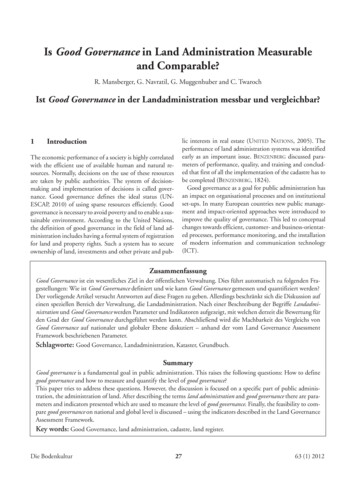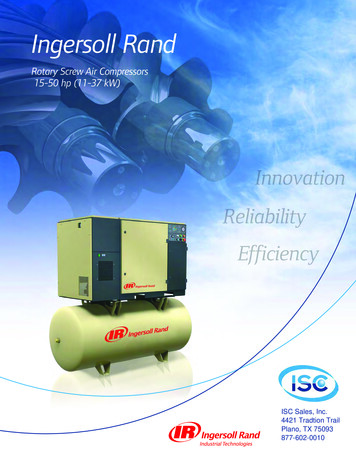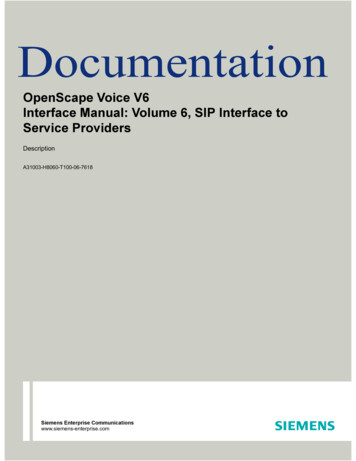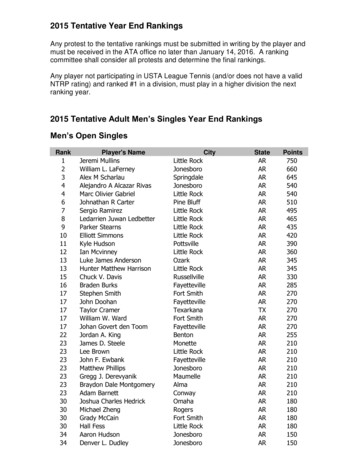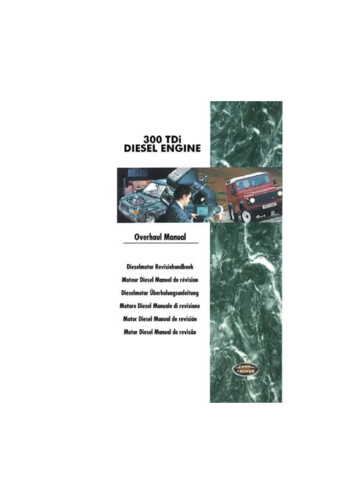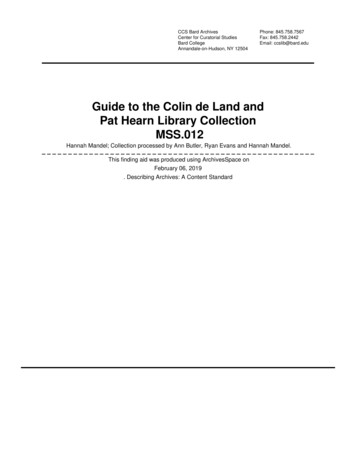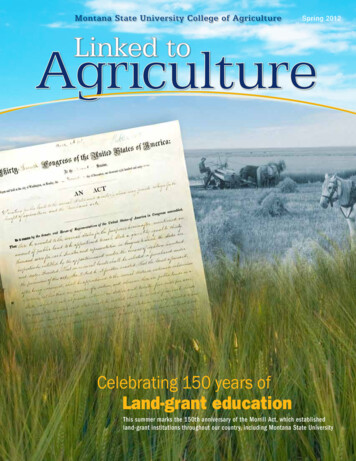
Transcription
Montana State University College of AgricultureSpring 2012Celebrating 150 years ofLand-grant educationThis summer marks the 150th anniversary of the Morrill Act, which establishedland-grant institutions throughout our country, including Montana State University
President Abraham Lincoln oversawthe establishment of the United StatesDepartment of Agriculture. He signedthe Homestead Act and the MorrillLand-Grant Colleges Act along with otherkey pieces of legislation that paved the wayfor westward expansion and eventuallyMontana State University. It is fascinatingfor me to think about all of the changesof the past 150 years—especially whenlooking at it from a MSU perspective.We have completed yet another amazingyear in the College of Agriculture(COA), and I cannot help but reflecton the accomplishments of ourstudents, staff, and faculty. Agriculturehas been around forever. Yet everyyear researchers discover new andmore efficient ways to do things,and they pass that new knowledgeon to students beginning careers inagriculture. The COA professors engagein a time honored profession balancingtime-proven methods with innovativeresearch and new technologies. As thesestudents transition into the work force,I can’t help but ponder the state of theCollege, the University, the students andthe entire agricultural community. Thisyear as the class of 2012 graduates theDepartment of Agriculture celebrates its150th anniversary.In 1862 in the midst of the Civil WarWhile the United States practiced“modern” farming and ranching, Montanawas not a state but part of the OregonTerritory. John Francis Grant settledin the fertile valley near present dayDeer Lodge in 1858 and by 1862 wasnursing worn out cattle from pioneerstraveling on the Overland Trail back tohealth. He then traded one healthy cowfor two unhealthy ones. Conrad Kohrsstarted marketing cattle to the miningcommunities and the cattle industry wassoon thriving. Trappers traveled along theMissouri River and traded furs at FortBenton, and Native Americans populatedthe vast territory.It is amazing to think of all of theadvancement during the past 150 years.And yet everything we do is still for thesame purpose—enhance production,resource stewardship, and create newknowledge. Abraham Lincoln said,“Every blade of grass is a study and toproduce two where there was but one,is both a profit and a pleasure.” I amsure that when you talk to farmersin Montana they can appreciate thatsentiment and are grateful to theknowledge gained through 150 years ofresearch and education.Therefore this issue of Linked toAgriculture profiles key research projectsongoing at MSU and the MontanaAgricultural Experiment Station. Wehave come a long way in 150 years,but our mission is just as critical as itwas then. We must continue to exceland to optimize our resources. Even aswe celebrate our accomplishments wemust compete for funding, both at thefederal and state levels. There are thosewho want to cut agricultural researchspending—we must not let that happen.Agriculture is critical to our community,our country, and our world. We mustrecruit and retain the best studentsand faculty, and we can only do thatwith the firm and more vocal, actionoriented citizenry that benefit from ourefforts. Please join us in celebrating thisimportant anniversary of the Departmentof Agriculture and look forward to thenext 150 years. Just imagine what wemight be able to do then!Jeff Jacobsen Dean and DirectorCollege of AgricultureMontana Agricultural Experiment Station2012 Awards for ExcellenceThe College of Agriculture (COA)celebrated the accomplishments of threegraduating seniors at the 30th annualAwards for Excellence banquet in the StrandUnion Ballroom in February. HannahBigelow, biotechnology, Missoula, Mont.,Erin Gunnick, environmental horticulture,Bozeman, Mont., and Megan Podolinsky,environmental biology and Spanish, Helena,Mont. were honored during the eventhosted by the Bozeman Area Chamber ofCommerce and the Alumni Foundation onFebruary 21. Students recognized must havea minimum cumulative grade point averageof 3.5, an exemplary record of campus andcommunity involvement, and a substantivehistory of service.The three COA seniors were nominatedthrough their respective departments,and then selected by university deansand campus committees. Recipientsof the Award for Excellence invite thefaculty or staff member who has beenmost inspirational and influential in theirundergraduate careers. The unique structureof the Awards for Excellence—studentstaking the stage alongside their designatedmentors—makes for a memorable occasion,and brief commentaries submitted byawardees highlight the evening’s program.Involvement Award. The “Torley Award”designates MSU’s best of the best, “seniorswith outstanding academic achievementsand a record of campus involvement—whoalso give of themselves for the betterment ofthe community.”“Sharing her energy and talent seemsto be second-nature for Megan,” Poolecommented during the selection process,Bigelow selected Rebecca Mattix, the pre-vet “so much so that her scholarship and serviceappear almost effortless. Yet she workscurriculum advisor and faculty from ImID.hard. Megan’s leadership and kindness haveMattix received two Awards for Excellenceearned her the respect of not just those whothis year as she was also chosen by Amandanominated her for this award, but also theZellar (organismal biology) through therespect of her classmates and peers.”College of Letters & Science. Mattix wasthe only mentor selected by two students.Congratulations to all of our outstandingGunnick tabbed her academic advisor,2012 awardees! Professor Bill Hoch (PSPP). PodolinskyABOVE: Left to right: Nora Smith, Hannah Bigshared the stage with Professor Geoffreyelow, Rebecca Mattix, Erin Gunnick, Bill Hoch,Poole from LRES, and additionally,GeoffPoole, and Megan Podolinskyreceived the Torlief Aasheim CommunityASMSU Changes Representation StructureThe Associated Student of Montana State University (ASMSU) serves as the students’ elected voice for Montana StateUniversity. Previously students elected representatives based on where they lived, but now they elect their representatives fromtheir colleges. There are 21 ASMSU senators and the COA has one elected representative. The College of Agriculture’s ASMSUsenator is Rachel Abeh, majoring in agriculture education-relations with a minor in rangeland ecology and management. Abehis involved in several activities at MSU: Chi Omega, Collegiate FFA, MSU“I am committed to giving theLivestock Judging, MSU Range Club (vice president), Society for RangeManagement Student Conclave (national vice president), and Collegiatesmallest college the largest voiceYoung Farmers & Ranchers. Abeh represents the college well and is a strongin ASMSU, and demonstrating theadvocate for the agricultural industry. Abeh says, “I am committed togiving the smallest college the largest voice in ASMSU, and demonstratingimportance of the College of Ag.”the importance of the College of Ag.” —Rachel Abeh23
with conventional machinery, but it issusceptible to drought and hail. Lentils arewell adapted to the MonDak region andare used for food. However, it is at risk tomajor diseases and sensitive to herbicideresidue or drift. It is also a poor weedcompetitor. Chickpea has good marketpotential and does well in the NorthernPlains climate. A fungus called Ascochytahas limited production of chickpea aroundthe world. Chickpea has a low cuttingheight and a high seed cost.For more on pulse crops go er.html or call 406-994-5431.Student Internships inAgricultural EducationDevon Ragen, GraduateStudent (Animal Science)injecting a marker helpestimate forage intake.Research UpdatesAg Appreciation WeekendDuring Ag Appreciation Weekend 2011, the College of Agriculture hosted a MSU Ag Fair with interactive boothsfrom the college’s departments and from several of the state’s agricultural organizations. At the fair, departmentalexperts offered mini-lectures during breakout sessions on a wide variety of topics. Following are excerpts fromthe presentations. These brief synopses highlight some of the College of Agriculture and the Montana AgriculturalExperiment Station’s salient research.Pulse Crops 101: From Humus to HummusIt seems researchers in Montana aregetting excited about pulse crops, but notnecessarily for the same reasons. While Dr.Prashant Jha, SARC scientist, recommendsusing pulse crops in rotation with cerealgrains to ease the pressure on fields wherespecific weeds have developed a resistanceto herbicide, Dr. Perry Miller, professorin the Department of Land Resourcesand Environmental Sciences, explainedhow incorporating pulse crops into weedmanagement can lead to more sustainableagricultural practices. Miller is workingwith a graduate student, MacdonaldBurgess, to explore how pulse crops change4the energy costs associated with grainproduction and also improve soil quality.Miller argues the number one energy inputin growing wheat in the United States is thenitrogen from fertilizers. He stated that halfthe energy budget in agriculture is in theform of fertilizer. Planting pulse crops likepeas can change that balance. According toresearch findings, wheat yield wasgreater in crops that were rotatedwith peas.During the breakout session inOctober, Miller also shared howlentils and peas were suited to theSeedsMontana climate as well as risk factorsinvolved in adding them to croppingsystems. Pulse crops evolved in semiaridclimate contexts in the Mediterraneanarea, similar to Montana’s semiaridclimate. Dry pea is a versatile crop used forfood, feed, forage or fuel. It is a moisturemiser and can be seeded and harvestedThe faculty from the Agricultural EducationDepartment work daily with Montana’smost important natural resource—its people.And they are preparing their students to dothe same. In October students shared theirexperiences as student interns. ShalaineWatson, an agricultural education (Ag Ed)major from Forsyth, Mont., chose ag edbecause of her diverse interest in agriculture.As an ag ed major in the teaching option,she could study a variety of agriculturetopics and not need to specialize. Watsonsaid, “College in general taught me to thinkoutside the box and how pertinent it is tobecome a life-long learner and keep up onthe most recent agricultural knowledge.”Watson’s student teaching experience was inRichey, a small town in eastern Montana.She found it challenging to balanceclassroom and experiential learning whenteaching animal husbandry to freshman,range science to sophomores, Montanaagriculture to seventh graders, and floriculture to juniors all in one day. She said,“My time at MSU taught me to prioritizewhat was important to me and to alwaysput in my best effort.” While attending theNational FFA Convention with the Richeystudents, Watson realized there is a strongconnection and thread of appreciationbetween agricultural students and teachersacross the country. “I think ag teachers havea unique opportunity to connect with theirstudents and their community on a differentlevel than other teachers,” she said. Throughher student teaching experience, Watsonrealized this career path is what she is meantto do and looks forward to a rewardingcareer in agricultural education.Graduate student Nikki Bailey, from FortBenton, Mont., earned a bachelor’s degreein agricultural education with a focus onag relations. While interning at the JudithBasin County Extension Office, Baileyplanned and managed several camps, toursand fairs, and learned about the countyExtension office’s daily work. Through thisexperience, Bailey learned communication and organizational skills, and howto work with a variety of people. Baileyalso learned the details of organizing andrunning a successful county 4-H fair. Shefelt the internship offered insight into thechallenges and rewards of a career as anExtension agent. “My internship gave me achance to network with many people in theagricultural industry and to use the skillsI learned in class in a real life hands-onexperience,” said Bailey.International EducationalExperiences for AgriculturalEconomics and EconomicsUndergraduate StudentsThe last issue of Linked to Agriculturefeatured two courses, Follow the Grainand Conception to Consumption, whichthe Department of Agricultural Economicsand Economics offer. These courses providestudents with a unique internationalperspective. Gary Brester, professor ofagricultural economics, shared with theAg Fair audience the history, structure andfuture plans for the classes. The courses aretaught every two to three years and weredesigned to help students follow food fromgenetics to consumption while providingan international experience. Students inthe Follow the Grain course have visitedmore than nine countries scattered aroundthe globe. During the course experts fromacross disciplines interact with students andprovide them a broad view of the commodity industry. Students research differenttopics and regions and present lecturesto the class. Students must participatein the international travel and pay theirown expenses. Faculty traveling with thestudents also pay their own expenses andare not subsidized by student fees or othercosts. The trips are normally after thesemester ends or during spring break.The department is focusing on grants andendowments to help with future studentand faculty travel. They are also developingrelationships with international experts inplaces like New Zealand and Croatia. Thedepartment’s goal is to welcome these expertsto MSU for a few weeks. According to Bresterthe visitors-in-residence provide another component to the learning experience and alsowill help with international travel logistics.The department has also developed acooperative relationship with the Fort PeckCommunity College and is working toAgriculural economics and economics undergraduates students5
Research Updatesreduce barriers for students wanting to participate in these courses and continue theireducation at a four-year institution.Colic in HorsesDr. Shannon Moreaux, veterinarian andassistant professor in the Department ofAnimal and Range Sciences, spoke aboutcolic in horses. Moreaux explained colicis not a diagnosis, but a description ofabdominal pain for a variety of conditionsand abnormalities. There are more than100 known causes of colic, the mostcommon cause of premature death indomesticated horses. The estimated annualcost of horse colic in the United States is 145 million.According to Moreaux there are severalcauses for colic: the stretching or inflammation of the intestinal wall, excessive tensionon the mesentery (the material that holdsthe intestines to the wall of the abdomen)or restrictions of the blood supply are afew common causes. Predisposing factorsinclude age, sex, breed, diet, exercise, andsome environmental conditions. MindyBrown, director of finance for the Collegeof Letters & Science, attended the breakout session in October. “Dr. Moreaux hasa wonderful ability to break down complexideas, so they are more easily understood,”Brown stated. “He is a wonderful educatorand is always current,” she added.6cont.herbicideresistant.may be considered, such as oilseeds, pulsesand forages,” he added.During the lecture Dr. Moreaux sharedsome of the most common clinical signs ofcolic which include pawing, rolling, abdominal distension, kicking at the abdomen, andanxiety. According to Brown this information was extremely valuable for horse ownerslike herself. When her own horse displayedsigns of colic, Brown immediately recalledthe information Moreaux shared and wasable to quickly recognize the signs and takeappropriate action.Jhaand hisresearchstaffsuspectKochia,commonlyreferred to astumbleweed, is nowresistant to glyphosate, (Roundup ) one ofthe most widely used herbicides in Montana.There are already resistant varieties of it inKansas, Nebraska, Colorado, and Alberta.Glyphosate-resistant Kochia is a majorconcern in sugar beet fields, because morethan 99 percent of the growers rely solely onglyphosate for weed control. Therefore Jharecommends an integrated weed management(IWM) program to prevent the spread ofherbicide-resistant weeds.If you would like more information, pleasecontact the Southern Agricultural ResearchCenter at 406-348-3400.Moreaux pointed out that often horses withcolic require medical treatment involvingmedications, fluid and electrolyte therapy,laxatives, manipulation or even surgery.During the breakout session those who attended Moreaux’s lecture were intrigued bythe virtual tour of the horse’s gastrointestinaltract used to demonstrate how colic evolves.While Brown had heard about the virtualtour on the internet it was her first opportunity to see it. She said it was extremelybeneficial and made it easier to understand avery complex issue such as colic.Herbicide Resistance: AChallenge to Montana CropProductionPrashant Jha, assistant professor and weedscientist at the Southern Ag Research Center(SARC) at Huntley, MT shared critical information for farmers across the State aboutherbicide resistant weedsand the current focus ofresearch at the center. Jhasummarized the researchinto three key areas:screening for herbicideresistant weed biotypes,investigating mechanismsfor resistance, andexploring alternativestrategies for fightingthe resistance. At theHuntley center, researchers are concerned manyherbicides previously usedin Montana are no longereffective. In Montanawild oats, Persian darnel,and Russian thistle areWhen using herbicides Jha advises growersto apply it at the rate suggested by themanufacturer and to use a tank mixturewhich includes multiple herbicide products.Jha’s research involves evaluating newherbicide chemistries and optimizingherbicide tank-mixes, and studyingapplication timing and rate in diversifiedcrops grown in Montana. Jha suggestedusing soil-applied residual herbicides at orprior to planting can potentially reduceweed bank recruitment and reduce weedinterference, especially early in the season.Diversifying crop rotations is also a criticalcomponent to IWM, and scientists at theSARC recommend rotating pulse cropssuch as peas and lentils—especially wheregrowers have traditionally relied on wheatfallow rotations. Jha also advises highseeding rates for crops as a long term weedmanagement strategy.Fertilizers also impact IWM as lownitrogen rates may demand more intensiveweed management. The weeds tend togrow better than crops under poor soilnitrogen conditions. “It is only throughthe development and implementation ofan IWM program that the problem canbe effectively managed,” said Jha. “A goodprogram will balance physical, cultural,biological and chemical aspects of weedscience. Economically viable rotation cropsImmunology and InfectiousDiseases Research UpdateMark Jutila, Ph.D., a leading scientistwith Immunology and Infectious Diseases(ImID), provided an overview of criticalongoing research projects in the department.Jutila introduced the audience to somediseases that may be transferable betweenwildlife, livestock and people and providedan update of current multi-facetted researchactivities regarding these diseases. Jutilastated that digestive and respiratory diseasesstill account for more than 50 percentof the non-predator deaths in calves inMontana and scientists at MSU are workingdiligently to discover vaccines and treatments that can minimize these losses.Jutila pointed out the need to learn moreabout bovine specific immunity, so theycan improve the effectiveness of the vaccines. Our current knowledge of protectiveimmune responses is primarily based onwork done in rodents and humans. Whilethere are similarities with bovine immuneresponses there are also clear differences.A key difference is in the immune cells:cattle have far more of a unique T cellcalled gamma/delta than humans androdents. According to research assistantprofessor Jodi Hedges who works withJutila, researchers at ImID are studyingthese special cells which comprise a largepercentage of the infection fighting cells inbovine blood and play a vital role in immunology of cattle. Researchers are exploringnovel approaches to both the compoundsand the delivery methods. They want todevelop products and procedures that arenot only safe, simple, and low cost, butwill still stimulate immunity in cattle.Scientists are currently testing a compound,Amphotericin B, (AMB) in cattle. AMB iscurrently used to fight fungal infectionsin humans. Researchers are testing AMBin calves and dairy cows using differentdelivery methods like strips that dissolve onthe tongue. For more information about this project contactImID at 406-994-4705.Recently, Dean Jacobsen and I were in Washington D.C.visiting MSU alumni. As we made our way around ournation’s capital, learning about our alumni and their careeraccomplishments, there was a familiar theme. The foundation of success originating from the likes of Linfield Hall atMontana State University echoed comments I’ve heard standing in a wheat field or leaning on a fence post in Montana.Whether you graduated forty years ago or four years ago,the experience was the same. Sure, technology and faceschange, but the quality education remains constant. And yes, we have new buildings,but students still go to class. It seems every alumnus can share a story about a professoror advisor who took a moment to help them as a student to make a difference. We neverwant to lose that student/staff connection in the College of Agriculture.Dean Jacobsen and I discussed the emerging financial needs of the students and faculty —the people of the COA. The relationship is symbiotic. They need each other, and they needfinancial support including scholarships for the students and endowments for the faculty.We are fortunate to have a healthy number of scholarships within the College. As ourstudent numbers increase, so does the need for scholarship dollars. We welcome ourgrowing student population in the College. These young people are ambitiously lookingto improve the world, accomplishing remarkable feats en route to a degree. Many needfinancial assistance to get there. If you have given any amount to a scholarship, wecannot thank you enough.Faculty support is a relatively new need within the College. To recruit and retainfaculty, we need private support. Why? Earlier this month the Office of InstitutionResearch and Assessment compiled a report for the Association of AmericanUniversities. The report rank-ordered universities considered very high research institutions. Of the 92 universities in the report Montana State University was last in everycategory for faculty salaries. In other words we pay our professors, associate professors,and assistant professors the lowest salaries of these Universities. We must become morecompetitive. And to do so, we need to raise funds to keep our intellectual capital onthe MSU campus. We do not want to lose faculty to a university who can simply paymore. We can help keep our incredible faculty through endowments. Endowments canprovide funds for salaries, program support, and equipment. We must invest in ourfaculty, as they provide the mentoring and education to our students.Finally, programs are often the place where students and faculty come together. Programfunds can assist with the likes of Follow the Grain, field experiences, cropping systemsresearch, sustainable agriculture teaching and Conception to Consumption. There are manyother programs needing financial assistance which state funds cannot assist. Students andfaculty request minimal funds in order to establish a new program. Providing these resourcescan lead to impactful developments from the College, originating from students or faculty.As Dean Jacobsen and I had these conversations in D.C., we had a similar message ofthanks to our friends and alumni. Thank you to each and every one of you who reachedinto your pocket and made a donation to the College of Agriculture. Your contributionsare making a difference. On behalf of the College, thank you!Sincerely,Darin PaineDirector of DevelopmentDarin Paine can be reached at darin.paine@montana.edu or (406) 994-76717
2012 EventsMultiple Copies Cause ConcernJune 19On behalf of the Alumni Foundation, I would like to extend my personal apology for theinconvenience you may have experienced as a result of receiving multiple copies of theCollege of Agriculture mailings this past December.June 20July 12July 19July 25June 28Sept. 7Oct. 26Dec. 15Central ARC Field Day,MoccasinSouthern ARC Field Day,HuntleyNorthern ARC Field Day,HavreEastern ARC Field Day,SidneyNorth Western ARC Field Day,KalispellWestern ARC Field Day,CorvallisScholarship BanquetCelebrate Agriculture!! (newname for annual Ag event)Fall CommencementKeep up with the College ofAgriculture on Facebook. Search for“College of Agriculture” or “MSU Collegeof Agriculture.”It is important that you know that the error was not caused by the administration or staff ofthe College of Agriculture. Mailing addresses and contact information for campus publications and newsletters are provided by the Alumni Foundation. Though our team strives toperform perfectly in our data management efforts, we failed to do so this past December.It is our goal to provide an exceptional experience on every occasion, so that our University mayenjoy the lifelong support and advocacy of our loyal alumni and friends. Be assured that we haveisolated the cause of December’s issue and have reformulated our protocols to prevent a reoccurrence.I hope that we can restore your confidence in us, as we work diligently to improve your experience with the College of Agriculture. Your continued support of Montana State Universityis important.Sincerely,Michael StevensonPresident & CEO, Montana State University Alumni FoundationLinked to Agriculture is published by the MSU College of Agriculture, 202 Linfield Hall, Bozeman, MT 59717; tel: 406-994-3681; fax: 406-994-6579;email: agdean@montana.edu; http://ag.montana.edu. Cover photo: Kelly Gorham, MSU University Communications; Contributors: Anton Bekkerman,Matt RognlieReturn Service RequestedCollege of AgricultureMontana State University202 Linfield HallBozeman, MT 59717Permit No. 69Bozeman, MT 59715PAIDNon-profit OrganizationU.S. Postage
The Associated Student of Montana State University (ASMSU) serves as the students' elected voice for Montana State University. Previously students elected representatives based on where they lived, but now they elect their representatives from their colleges. There are 21 ASMSU senators and the COA has one elected representative.
